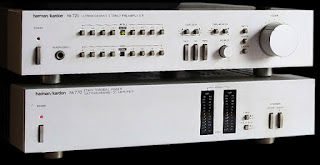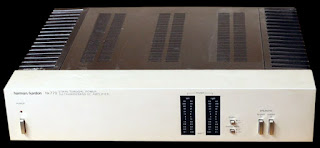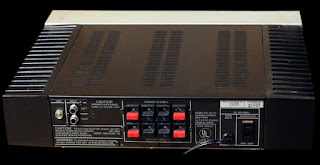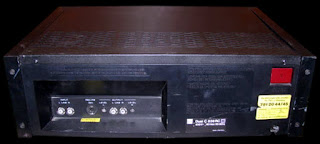In its B780 receiver
Revox has achieved a truly symbiotic relationship between tuner and amplifier.
Each retains its identity; the circuitry and performance of both the B760
Digital Frequency Syntesizer FM Tuner and the Revox B750 Integrated Amplifier
are combined in the B780. instaed of trading flexibility for single-unit
convenience, however, the capabilities of each unit have been enhanced by their
merger into the Revox B780.
What makes the B780
more than the sum of its component parts is a microprocessor unit that takes
over switching functions that would normally require an inordinate number of
hard-wired connections and printed circuits. At the same time that it serves to
increase the reliability of the B780, the microprocessor control system makes
the receiver even easier to use.
As the nerve center
for your entire component high-fidelity system, the Revox B780 provides
connection and control facilities for two loudspeaker systems and for
fourstereo sources in addition to its built-in FM tuner; a phono cartridge, two
tape recorders, and an auxiliary source, such as a Tv set, AM tuner, or the
like. Each input is fully buffered, and so, can be used independently. That is
to say, if you wish, you can record an FM broadcast on your open real deck at
the same time as you are listening to the playback of an LP. in place of the
usual rotary "Selector Switch", your choice of input signals is
electronically routed through the amplifier via individual pushbuttons ( with
lighted indicators) that command the microprocessor to switch to the
appropriate source. Even when the B780 is turned off, the microprocessor
retains the last-selected program source in its memory, so when you turn the
unit on again. It "wakes up" properly switched to that input.
Lighted digits show
which program source is going to the recorder circuits. These pushbutton
choices are also retained in the microprocessor memory, giving you the
convenience of mechanical switching with vastly improved reliability.
The same principle
of all pushbutton operation is applied throughout the tuner section of the
B780. there is no conventional FM dial for the selected station frequency, as
it is indicated ( to two decimal places ) on a digital red-out. There is no
conventional FM dial for selected station frequency, as it is indicated on a
digital read-out. There is no conventional tuning knob, with its dial cord and
pulleys; rather; pushbuttons cause the tuner to scan upward or down-ward in
frequency in 50 kHz incrementes, stopping at each receivable station, or at
each stereo station, or switching into mono when the station's signal strength
is not adequate for proper stereo reception.
Because of its
quartz-crystal controlled frequency synthesizer, tuning is always exact; only
by using a laboratory FM generator and distortion analyzer could such precision
be obtained with normal manual tuning. And the pushbutton memory system of the
B780 allows you to store the frequencies of up to 18 favorite stations for
instant recall.
Long awaited, the
Revox B780 receiver embodies the most up-to-date technology, in its most
convenient form, in the service of the one goal that inspire all Studer Revox
products; to bring you the most faithful possible reproduction of musical
sound.
Specifications:
Tuner Section
Tuning Range: 87,50 - 107,975 MHz
Tuning
Accuracy: ±0,0025%
IHF (30-dB)
Monophonic Usable Sensitivity: 19,µV /
300 Ω (10,8 dBf)
IHF (IHF-T-200)
Monophonic 50 dB Quieting Sensitivity:
2,5 µV / 300 Ω (13,2 dBf)
IHF (IHF-T-200)
Stereophonic 50 dB Quieting Sensitivity:
30 µV / 300 Ω (34,8 dBf)
Image
Rejection: 106 dB
IF Rejection: 110 dB
Spurious Response
Ratio: 106 dB
Capture Ratio (at 65
dBf): 2 dB
Selectivity Adjacent
Channel: 16 dB
Selectivity
Alternate Channel: 78 dB
AM Suppression: 70 dB
Subcarrier Product
Rejection: 72 dB
Frequency
Response: 30 Hz - 15 kHz ±1 dB
Deemphasis: 50 or 75 µs (switchable) with built-in Noise
Reduction Unit 25 µs
Total Harmonic
Distortion(at 65 dBf):
At 100 Hz : 0,15% (mono);
0,35% (stereo0
At 1 kHz : 0,1 (mono);
0,25% (stereo)
At 6 kHz : 0,2% (mono);
0,2% 9stereo0
Stereo Separation
[Mono]:
At 100 Hz : 40 dB
At 1 kHz : 42 dB
At 10 kHz : 33 dB
Signal-to-Noise
ratio 9at 65 dBf):
Mono : 78 dB
Stereo : 74 dB
Muting Thresholds:
Mono : 17,3 - 37,3 dBf
Stereo : 25,2 - 65,2 dBf
Antenna Inputs:
60 -75 Ω coaxial
240 - 300 Ω balanced
Audio Outputs:
75 kHz deviation/400
Hz equals 0,7 volt at the output Tape 1
15 kHz deviation/400
Hz produces 70 watts/ 8 Ω at the output Speakers A/B
Oscilloscope Output:
Vertical : 50 mV /75 Ω, RF =1 Volt
Horizontal : 75 kHz deviation = 2,8 Volt pp
Amplifier Section
Power Output: 70 watts/channel min. RMS into 8 Ω from 20 Hz
- 20 kHz with no more than 0,05% T.H.D.
Total Harmonic
Distortion: 0,03% at rated output
IHF Intermodulation
Distortion (14 kHz/15 kHz): less than
0,03% at rated output
TIM Distortion
(Otala, lowpass 10 kHz): less than 0,08%
at rated output
Dynamic
Headroom: 1 dB
Slew rate:
15 V/µs ( limited by
internal low pass filter)
30 V/µs (without low
pass filter0
Frequency
Response: 20 Hz - 20 kHz +0 dB/-0,7 dB
Damping Factor: better than 100 at 8 Ω and 1 kHz
Inputs Sensitivity
(for 70 watts [8 Ω])/Impedance
Aux, Tape 1, 2
: 150 mV/50 k Ω
Phono : 3 mV/47 k Ω, 220 pF
PWR In : 1 V/50 k Ω
Input Overload
Margin (phono, Aux, Tape 1, 2): better
than 30 dB
Outputs;
DIN Connector Tape
2/Out: 5,5 mV/R 10 Ω
Speakers A, B : 23,7 V (8 Ω)
Tape 1 : 135 mV/R min. 47 k Ω
Pre Out (DIN
connector) ; 0,85 V/R min. 10 k Ω
Pre Amp Out (jack)
: 0,85 V/R min. 47 k Ω
Phones : 11,8 V/R 220 Ω
Signal-to-Noise
Ratio (RMS value, unweighted 20 Hz - 20 kHz relative to 70 W/8 Ω)
Aux, Tape 1, 2
: better than 90 dB
Phono 1 + 2 9ref. 5
mV, A-weighted): better than 82 dB
Crosstalk (at 1
kHz): better than 70 dB
Phono
Equalization: 20 Hz - 20 kHz ±0,5 dB (in
accordance with IEC 98, MOD 4 1976, consistent with RIAA)
Tone Controls:
Bass : ±8
dB at 120 Hz
Treble : ±8 dB at 8 kHz
Presence ; ±8 dB at 3 kHz
Filters:
Low : 50 Hz, -3 dB (12 dB/oct)
High : 8 kh, -3 dB (12 dB/oct)
Loudness (Vol-40
dB): 100 Hz +5 dB , 10 kHz +6 dB
General Section
Semiconductors: 122 Transistors; 99 Diodes;
19 variable capacity Double Diodes:
46 ICs: 1 micro-processor; 4 K x
8 Bit, 5 Bridge Rectifiers, 9 7-Segment Displays
Electric Current
Supply: 100, 120, 140, 200, 220, 240 V
AC ±10% (voltage selector) 50/60 Hz
Power
Consumption: 550 W max.
Dimensions (W x H x
D): 452 x 151 x 420 mm (17,8" x
6" x 16,5 ")
Weight: 17 kg (37 lbs)






























